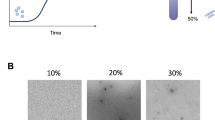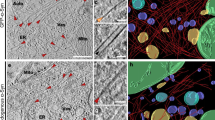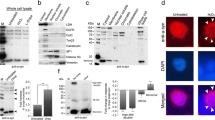Abstract
Recently, we demonstrated that soluble 30–50 nm-sized nnular α-synuclein oligomers are released by mild detergent treatment from glial cytoplasmic inclusions (GCIs) purified from multiple system atrophy brain tissue (Pountneyet al., J. Neurochem. 90:502, 2004). Dynamic antibody recognition imaging using a specific anti-α-synuclein antibody confirmed that the annular structures were positive for α-synuclein. This showed that pathological α-synucleinopathy aggregates can be a source of annular α-synuclein species. In contrast to pathological α-synuclein, recombinant α-synuclein yielded only spherical oligomers after detergent treatment, indicating a greater propensity of the pathological protein to form stable annular oligomers.In vitro, we found that Ca2+ binding to monomeric α-synuclein, specifically amongst a range of different metal ions, induced the rapid formation of annular oligomers (Loweet al., Protein Sci., 13:3245, 2004). Hence, α-synuclein speciation may also be influenced by the intracytoplasmic Ca2+ concentration. We also showed that annular α-synuclein oligomers can nucleate filament formation. We hypothesize that soluble α-synuclein annular oligomers may be cytotoxic species, either by interacting with cell membranes or components of the ubiquitin proteasome system. The equilibrium between α-synuclein species may be influenced by intracellular Ca2+ status, interaction with lipid vesicles or other factors.
Similar content being viewed by others
Abbreviations
- AFM:
-
atomic force microscopy
- CHAPS:
-
3-[(3-Cholamidopropyl) dimethyl-ammonio]-1 -propanesul-fonate
- DLB:
-
dementia with Lewy bodies
- GCI:
-
glial cytoplasmic inclusion
- LB:
-
Lewy body
- MSA:
-
multiple system atrophy
- ROS:
-
reactive oxygen species
- PD:
-
Parkinson’s disease
References
Bucciantini M, E Giannoni, F Chiti, F Baroni, L Formigli, J Zurdo, N Taddel, G Ramponi, C Dobson and M Stefani (2002) Inherent toxity of aggregates implies a common mechanism for protein misfolding diseases.Nature 416, 507–511.
Campbell BC, CA McLean, JG Culvenor, WP Gai, PC Blumbergs, P Jakala, K Beyreuther, CL Masters and QX Li (2001) Solubility of α-synuclein differs between multiple system atrophy and dementia with Lewy bodies.J. Neurochem. 76, 87–96.
Chartier-Harlin MC, J Kachergus, C Roumier, V Mouroux, X Douay, S Lincoln, C Levecque, L Larvor, J Andrieux, M Hulihan, N Waucquier, L Defebvre, P Amouyel, M Farrer and A Destee (2004) α-Synuclein locus duplication as a cause of familial Parkinson’s disease.Lancet 364, 1167–1169.
Choi P, N Golts, H Snyder, M Chong, L Petrucelli, J Hardy, D Sparkman, E Cochran, JM Lee and B Wolozin (2001) Co-association f parkin and α-synuclein.Neuroreport 12, 2839–2843.
Conway K, J Harper and PT Lansbury (2000a) Fibrils formedin vitro from α-synuclein and two mutant forms linked to Parkinson’s disease are typical amyloid.Biochemistry 39, 2552–2563.
Conway KA, S Lee, J Rochet, T Ding, R Williamson and P Lansbury Jr (2000b) Acceleration of oligomerization, not fibrillization, is a shared property of both α-synuclein mutations linked to early-onset Parkinson’s disease: implications for pathogenesis and therapy.Proc. Natl. Acad. Sci. USA 99, 571–576.
Crocker S J, PD Smith, V Jackson-Lewis, WR Lamba, SP Hayley, E Grimm, SM Callaghan, RS Slack, E Melloni, S Przedborski, GS Robertson, H Anisman, Z Merali and DS Park (2003) Inhibition of calpains prevents neuronal and behavioral deficits in an MPTP mouse model of Parkinson’s disease.J. Neurosci. 23, 4081–4091.
Cuervo AM, L Stefanis, R Fredenburg, PT Lansbury and D Sulzer (2004) Impaired degradation of mutantC-synuclein by chaperone-mediated autophagy.Science 305, 1292–1295.
Davidson WS, A Jonas, DF Clayton and JM George (1998) Stabilization of ?-synuclein secondary structure upon binding to synthetic membranes.J. Biol. Chem. 273, 9443–9449.
Ding T, S Lee, J Rochet and PT Lansbury (2002) Annular α-synuclein protofibrils are produced when spherical protofibrils are incubated in solution or bound to brain derived membranes.Biochemistry 41, 10209–10217.
Eliezer D, E Kutluay, R Bussell and G Browne (2001) Conformational properties of α-synuclein in its free and lipidassociated states.J. Mol. Biol. 307, 10661–10673.
Fang Y, S Cheley, H Bayley and J Yang (1997) The heptameric prepore of a staphylococcal ?-hemolysin mutant in lipid bilayers imaged by atomic force microscopy.Biochemistry 36, 9518–9522.
Feany MB and WW Bender (2000) ADrosophila model of Parkinson’s disease.Nature 404, 394–398.
Fernandez-Lopez S, H-S Kim, EC Choi, M M Delgado, JR Granja, A Khasanov, K Kraehenbuehl, G Long, DA Weinberger, KM Wilcoxen and MR Ghadiri (2001) Antibacterial agents based on the cyclic D,L-α-peptide architecture.Nature 412, 452–455.
Fotiadis D, S Scheuring, SA Muller, A Engel and DJ Muller (2002) maging and manipulation of biological structures with the AFM.Micron 33, 385–397.
Gai WP, JHT Power, PC Blumbergs and WW Blessing (1998) Multiple system atrophy - a new α-synuclein disease?Lancet 352, 547–548.
Gai WP, JHT Power, PC Biumbergs, JG Culvenor and PH Jensen (1999) α-Synuclein immunoisolation of glial inclusions from multiple system atrophy brain tissue reveals multiprotein components.J. Neurochem. 73, 2093–2100.
Gai WP, HX Yuan, QX Li, JHT Power, PC Blumbergs and PH Jensen (2000)In situ andin vitro study of colocalization and segregation of α-synuclein, ubiquitin and lipids in cortical Lewy bodies.Exp. Neurol. 166, 324–333.
Gai WP, DL Pountney, JHT Power, QX Li, JG Culvenor, CA McLean, PH Jensen and PC Blumbergs (2003) α-Synuclein fibrils constitute the central core of oligodendroglial inclusion filaments in multiple system atrophy.Exp. Neurol. 181, 68–78.
Goedert M (2001) α-Synuclein and neurodegenerative diseases.Nat. Rev. Neurosci. 2, 492–501.
Goedert M and MG Spillantini (1998) Lewy body diseases and multiple system atrophy as α-synucleinopathies.Mol. Psychiatry 3, 462–465.
Hatters DM, CA MacRaild, R Daniels, WS Gosal, NH Thomson, JA Jones, JJ Davis, CE MacPhee, CM Dobson and GJ Howlett (2003) The circularization of amyloid fibrils formed by apolipoprotein C-II.Biophys. J. 85, 3979–3990.
Jensen PH and WP Gai (2001) α-Synuclein. Axonal transport, ligand interaction and neurodegeneration.Adv. Exp. Med. Biol.: Neuropath. Genet. Dementia 487, 129–134.
Jensen PH, K Islam, JM Kenney, MS Nielsen, J Power and WP Gai (2000) Microtubule-associated protein 1B is a component of cortical Lewy bodies and binds α-synuclein filaments.J. Biol. Chem. 275, 21500–21507.
Kahle PJ, M Neumann, L Ozmen, V Muller, H Jacobsen, W Spooren, B Fuss, B Mallon, WB Macklin, H Fujiwara, M Hasegawa, T Iwatsubo, HA Kretzschmar and C Haass (2002) Hyperphosphorylation and insolubility of α-synuclein in transgenic mouse oligodendrocytes.EMBO Rep. 3, 583–588.
Kanda S, JF Bishop, MA Eglitis, Y Yang and MM Mouradian (2000) Enhanced vulnerability to oxidative stress byC-synuclein mutations and C-terminal truncation.Neuroscience 97, 279–284.
Kitada T, S Asakawa, N Hattori, H Matsumine, Y Yamamura, S Minoshima, M Yokochi, Y Mizuno and N Shimizu (1998) Mutations in the parkin gene cause autosomal recessive juvenile parkinsonism.Nature 392, 605–608.
Kopito RR (2000) Aggresomes, inclusion bodies and protein aggregation.Trends Cell. Biol. 10, 524–530.
Kruger R, W Kuhn, T Muller, D Woitalla, M Graeber, S Kosel, H Przuntek, JT Epplen, L Schols and O Riess (1998) Ala30Pro mutation in the gene encoding α-synuclein in Parkinson’s disease.Nat. Genet. 18, 106–108.
Lashuel H, B Petre, J Wall, M Simon, R Nowak, T Walz and PT Lansbury (2002) α-Synuclein, especially the Parkinson’s disease-associated mutants, forms pore-like annular and tubular protofibrils.J. Mol. Biol. 322, 1089–1102.
Lee HJ and SJ Lee (2002) Characterization of cytoplasmic α-synuclein aggregates. Fibril formation is tightly linked to the inclusion-forming process in cells.J. Biol. Chem. 277, 48976–48983.
Li J, VN Uversky and AL Fink (2001) Effect of familial Parkinson’s disease point mutations A30P and A53T on the structural properties, aggregation, and fibrillation of human α-synuclein.Biochemistry 40, 11604–11613.
Lindersson E, R Beedholm, P Højrup, T Moos, WP Gai, KB Hendil and PH Jensen (2004) Proteasomal inhibition by α-synuclein filaments and oligomers.J. Biol. Chem. 279, 12924–12934.
Lowe R, DL Pountney, PH Jensen, WP Gai and NH Voelcker (2004) Ca2+ selectively induces α-synuclein annular oligomers via interaction with the C-terminal domain.Protein Sci. 13(12), 3245–3252. Epub 2004 Nov 10.
Malisauskas M, V Zamotin, J Jass, W Noppe, CM Dobson and LA Morozova-Roche (2003) Amyloid protofilaments from the Ca2+-binding protein equine lysozyme: formation of ring and linear structures depends on pH and metal ion concentration.J. Mol. Biol. 330, 879–890.
Martinez J, I Moeller, H Erdjument-Bromage, P Tempst and B Lauring (2003) Parkinson’s disease-associated α-synuclein is a calmodulin substrate.J. Biol. Chem. 278, 17379–17387.
Masliah E, E Rockenstein, I Veinbergs, M Mallory, M Hashimoto, A Takeda, Y Sagara, A Sisk and L Mucke (2000) Dopaminergic loss and inclusion body formation in α-synuclein mice: implications for neurodegenerative disorders.Science 287, 1265–1269.
McLean PJ, H Kawamata and BT Hyman (2001) α-Synucleinenhanced green fluorescent protein fusion proteins form proteasome sensitive inclusions in primary neurons.Neuroscience 104, 901–912.
McNaught KS, P Shashidharan, DP Perl, P Jenner and CW Olanow (2002) Aggresome-related biogenesis of Lewy bodies.Eur. J. Neurosci. 16, 2136–2148.
Mishizen-Eberz AJ, RP Guttmann, BI Giasson, GA Day 3rd, R Hodara, H Ischiropoulos, VM Lee, JQ Trojanowski and DR Lynch (2003) Distinct cleavage patterns of normal and pathologic forms of α-synuclein by calpain Iin vitro.J. Neurochem. 86, 836–847.
Nielsen MS, H Vorum, E Lindersson and PH Jensen (2001) Ca2+ binding to α-synuclein regulates ligand binding and oligomerization.J. Biol. Chem. 276, 22680–22684.
Outeiro TF and S Lindquist (2003) Yeast cells provide insight into α-synuclein biology and pathobiology.Science 302, 1772–1775.
Polymeropoulos MH, C Lavedan, E Leroy, SE Ide, A Dehejia,A Dutra, B Pike, H Root, J Rubenstein, R Boyer, ES Stenroos, S Chandrasekharappa, A Athanassiadou, T Papapetropoulos, WG Johnson, AM Lazzarini, RC Duvoisin, G Di Iorio, LI Golbe and RL Nussbaum (1997) Mutation in the α-synuclein gene identified in families with Parkinson’s disease.Science 276, 2045–2047.
Pountney DL, R Lowe, M Quilty, JC Vickers, NH Voelcker and WP Gai (2004) Annular α-synuclein species from purified multiple system atrophy inclusions.J. Neurochem. 90, 502–512
Power JHT, J Shanon, PC Blumbergs and WP Gai (2002) Non-selenium glutathione peroxidase in human brain: elevated level in Parkinson’s disease and dementia with Lewy bodies.Am. J. Pathol. 161, 885–894.
Quilty MC, WP Gai, DL Pountney, AK West and JC Vickers (2003) Localisation of α-, β- and γ-synuclein during neuronal development and alterations associated with the neuronal response to axonal trauma.Exp. Neurol. 182, 195–207.
Raab A, W Han, D Badt, SJ Smith-Gill, SM Lindsay, H Schindler and P Hinterdorfer (1999) Antibody recognition imaging by force microscopy.Nat. Biotech. 17, 902–905.
Schlossmacher MG, MP Frosch, WP Gai, M Medina, H Shimura, T Ochiishi, N Hattori, Y Mizuno, DJ Selkoe and KS Kosik (2002) Parkin and α-synuclein interact in normal brain and colocalize in Lewy bodies of Parkinson disease.Am. J. Pathol. 160, 1655–1667.
Shimura H, MG Schlossmacher, N Hattori, MP Frosch, A Trockenbacher, R Schneider, Y Mizuno, KS Kosik and DJ Selkoe (2001) Ubiquitination of a new form of ?-synuclein by parkin from human brain: implications for Parkinson’s disease.Science 293, 263–269.
Singleton AB, M Farrer, J Johnson, A Singleton, S Hague, J Kachergus, M Hulihan, T Peuralinna, A Dutra, R Nussbaum, S Lincoln, A Crawley, M Hanson, D Maraganore, C Adler, MR Cookson, M Muenter, M Baptista, D Miller, J Blancato, J Hardy and K Gwinn-Hardy (2003) α-Synuclein locus triplication causes Parkinson’s disease.Science 302, 841.
Snyder H, K Mensah, C Theisler, J Lee, A Matouschek and B Wolozin (2003) Aggregated and monomeric α-synuclein bind to the S6’ proteasomal protein and inhibit proteasomal function.J. Biol. Chem. 278, 11753–11759.
Song L, MR Hobaugh, C Shustak, S Cheley, H Bayley and JE Gouaux (1996) Structure of staphylococcal α-hemolysin, a heptameric transmembrane pore.Science 274, 1859–1866.
Souza JM, BI Giasson, Q Chen, VM Lee and H Ischiropoulos (2000) Dityrosine cross-linking promotes formation of stable α-synuclein polymers. Implication of nitrative and oxidative stress in the pathogenesis of neurodegenerative synucleinopathies.J. Biol. Chem. 275, 18344–18349.
Stefanova N, L Klimaschewski, W Poewe, GK Wenning and M Reindl (2001) Glial cell death induced by overexpression of α-synuclein.J. Neurosci. Res. 65, 432–438.
Tompkins MM, WP Gai, S Douglas and SJ Bunn (2003) α-Synuclein expression localizes to the Golgi apparatus in bovine adrenal medullary chromaffin cells.Brain Res. 984, 233–236.
Ueda K, H Fukushima, E Masliah, Y Xia, A Iwai, M Yoshimoto, DA Otero, J Kondo, Y Ihara and T Saitoh (1993) Molecular cloning of cDNA encoding an unrecognized component of amyloid in Alzheimer disease.Proc. Natl. Acad. Sci. USA 90, 11282–11286.
Uversky VN, J Li and AL Fink (2001) Metal-triggered structural transformations, aggregation, and fibrillation of human α-synuclein. A possible molecular link between Parkinson’s disease and heavy metal exposure.J. Biol. Chem. 276, 44284–44296.
Volles MJ and PT Lansbury Jr (2002) Vesicle permeabilization by protofibrillar α-synuclein is sensitive to Parkinson’s diseaselinked mutations and occurs by a pore-like mechanism.Biochemistry 41, 4595–4602.
Volles MJ and PT Lansbury Jr (2003) Zeroing in on the pathogenic form of ?-synuclein and its mechanism of neurotoxicity in Parkinson’s disease.Biochemistry 42, 7871–7878.
Weinreb PH, W Zhen, AW Poon, KA Conway and PT Lansbury Jr (1996) NACP, a protein implicated in Alzheimer’s disease and learning, is natively unfolded.Biochemistry 35, 13709–13715.
Wenning GK, C Colosimo, F Geser and W Poewe (2004) Multiple system atrophy.Lancet Neurol. 3, 93–103.
Zarranz JJ, J Alegre, JC Gomez-Esteban, E Lezcano, R Ros, I Ampuero, L Vidal, J Hoenicka, O Rodriguez, B Atares, V Llorens, E Gomez Tortosa, Tdel Ser, DG Munoz and JG de Yebenes (2004) The new mutation, E46K, of α-synuclein causes Parkinson and Lewy body dementia.Ann. Neurol. 55, 164–173.
Author information
Authors and Affiliations
Corresponding author
Rights and permissions
About this article
Cite this article
Pountney, D.L., Voelcker, N.H. & Gai, W.P. Annular alpha-synuclein oligomers are potentially toxic agents in alpha-synucleinopathy. Hypothesis. neurotox res 7, 59–67 (2005). https://doi.org/10.1007/BF03033776
Received:
Revised:
Issue Date:
DOI: https://doi.org/10.1007/BF03033776




